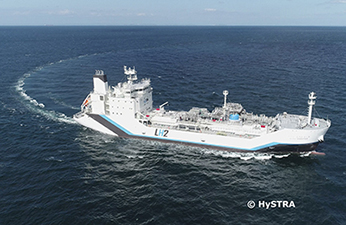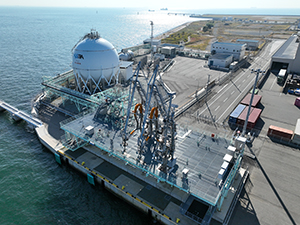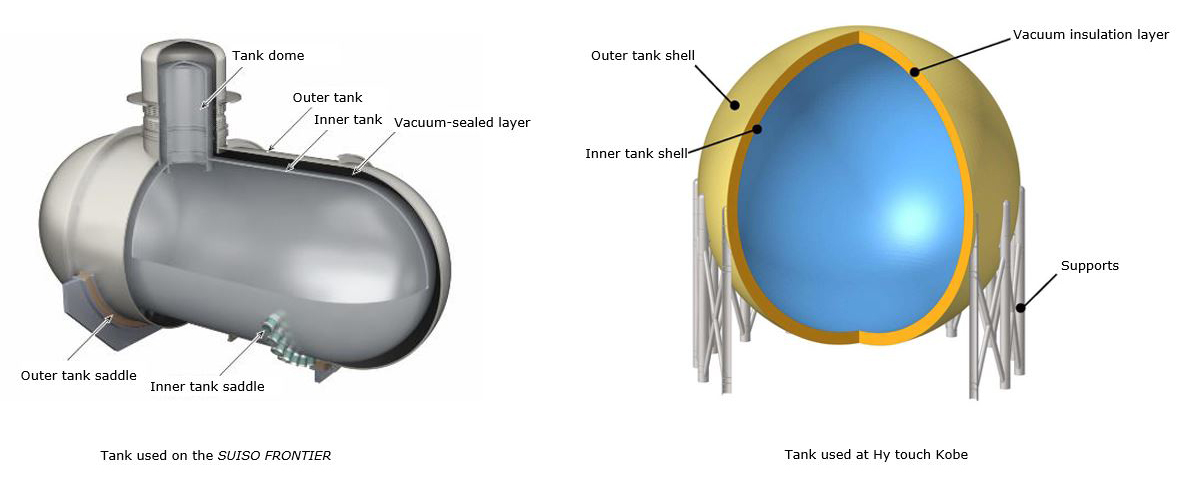Kawasaki Proves Excellent Thermal-insulation Performance for Liquefied Hydrogen Storage Tanks
Dec. 11, 2023
December 11, 2023 — Under the New Energy and Industrial Technology Development Organization (NEDO) Demonstration Project for Establishment of Mass Hydrogen Marine Transportation Supply Chain (hereafter, “NEDO pilot project”), Kawasaki has delivered liquefied hydrogen storage tanks and related equipment for the world's first liquefied hydrogen carrier SUISO FRONTIER (built by Kawasaki), and also for the world’s first liquefied hydrogen receiving terminal “Hy touch Kobe,” to the CO2-free Hydrogen Energy Supply-chain Technology Research Association (HySTRA), and is continuing with demonstration tests using these facilities and equipment.
The SUISO FRONTIER, following its initial departure in December 2021 from Japan for Australia, was used for pilot tests transporting liquefied hydrogen over a period of two years. The results of these tests showed a boil-off rate (BOR), which represents the rate of liquid that evaporates in a day due to natural heat ingress from the outside, of 0.3 percent per day for the SUISO FRONTIER liquefied hydrogen storage tank, and a BOR of 0.06 percent per day for the Hy touch Kobe onshore storage tank. Both results were well under the planned design rates, serving as proof of the tanks’ excellent heat-insulating performance. Moreover, both results are comparable with the BORs of liquefied natural gas (LNG) coastal vessels and LNG storage tanks of the same class.


Hydrogen is a clean energy source that emits no greenhouse gases during use in power generation, fuel cell vehicles (FCVs), and other such applications. Japan aims to introduce up to three million tonnes of this energy source annually by 2030, and therefore the development of storage technologies and other related infrastructure is critical to the realization of national targets.
For the NEDO pilot project, HySTRA is carrying out demonstration tests of technologies used to store cryogenic liquefied hydrogen, which is 1/800th of its initial volume as gas, and to transport it from Australia to Japan. The liquefied hydrogen storage tanks used onboard the SUISO FRONTIER and at Hy touch Kobe, which serve as vital equipment in both facilities, must provide long-term, stable storage for cryogenic liquefied hydrogen at a temperature of –253 degrees Celsius, without using external energy to maintain that cryogenic temperature. To this end, both tanks use a vacuum-sealed design featuring a double-shell structure with vacuum insulation between the shells to limit heat ingress to the maximum extent possible. After multiple demonstration tests entailing maritime transportation between Japan and Australia, Kawasaki has proved the excellent thermal -insulation performance of this design. The tank’s structure incorporates the knowledge Kawasaki has accumulated over 40 years operating the liquefied hydrogen storage tank it delivered in the 1980s to the Tanegashima Space Center operated by the National Space Development Agency of Japan (NASDA), the predecessor to today’s Japan Aerospace Exploration Agency (JAXA).

Kawasaki, as a participant in a NEDO-funded project*1 since FY2019, has built a liquefied hydrogen storage tank nearly identical in size to the large tanks to be used on large liquefied hydrogen carriers. The company has confirmed that the intended level of thermal -insulation performance can be achieved at this large scale as well. Kawasaki intends to apply these technologies in 40,000-cubic-meter capacity storage tanks for the large liquefied hydrogen carriers that will be built as part of NEDO Green Innovation Fund Project*2 to demonstrate the feasibility of a commercial-scale liquefied hydrogen supply chain (hereafter the “Commercialization Demonstration Project”). Kawasaki is also developing large onshore liquefied hydrogen storage tanks as part of another NEDO-funded project,*3 and the company intends to apply its superior insulation technologies to 50,000-cubic-meter class onshore tanks.
For the Commercialization Demonstration Project in the late 2020s, Kawasaki plans to develop a zero-emissions, large-scale liquefied hydrogen carrier that utilizes boil-off hydrogen as fuel. At the same time, the company is striving to improve the efficiency of tank-building operations through automation of welding and inspections, and to implement modular production approaches in which factory-assembled tanks are delivered for installation onsite, thus shortening lead times.
With an eye toward a future hydrogen society, Kawasaki is creating technologies intended to accelerate the establishment of liquefied hydrogen supply chain infrastructure. By providing a lineup of products for both Japan and abroad, the company strives to establish liquefied hydrogen supply chains in order to realize more stable energy supply tailored to each country’s demand and make hydrogen a commonplace energy source in our world of tomorrow on par with oil and natural gas at present.
| *1 | Technology Development Project for Building a Hydrogen Society: Technology Development for Using Hydrogen Energy on a Large Scale / Demonstration Project for Establishment of Mass Hydrogen Marine Transportation Supply Chain Derived from Unused Brown Coal (2015–2023) |
| *2 | A project that provides support over a ten-year period for corporations and other organizations aiming to tackle business challenges related to Japan’s goal of realizing carbon neutrality by 2050, covering everything from R&D to demonstration and commercialization. |
| *3 | Technology Development Project for Building a Hydrogen Society: Technology Development for Using Hydrogen Energy on a Large Scale / Development of Large-Scale Transport and Storage Equipment and Export and Import Terminal Equipment for Liquefied Hydrogen (2019–2022) |
Past Press Releases
Kawasaki Completes World's First Liquefied Hydrogen Receiving Terminal Kobe LH2 Terminal (Hy touch Kobe) (December 3, 2020)
https://global.kawasaki.com/en/corp/newsroom/news/detail/?f=20201203_2378
HySTRA celebrates completion of worldʼs first liquefied hydrogen vessel voyage in Japan (April 9, 2022)
https://global.kawasaki.com/news_220409-1e.pdf
Contact
If you need more information about our business,
please feel free to contact us.





